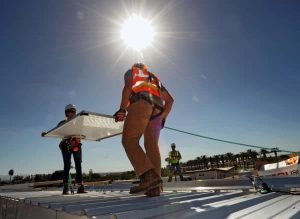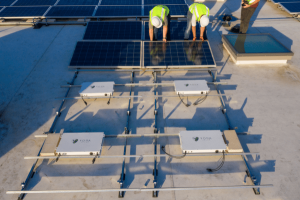
Rooftop array on a community center.
NC Solar Center
The last decade has brought tremendous growth for community solar, despite the fact that policies only exist in 20 states, plus D.C.
In 2010, there were only a few community solar projects to speak of compared to 2,529 MW as of Q3 2020. Community solar is uniquely positioned to aid in America’s recovery from the current Covid-induced economic recession, especially in hard-hit communities. It provides jobs—both temp and long term—lower-cost energy, tax revenue, and lease revenue to landowners and agricultural producers, all while helping to address environmental injustices.
he drivers behind the growth of community solar vary, but one of the most important is that it is the only mechanism that enables a large portion of the market to access renewable energy. Without community solar, 77% of U.S. households wouldn’t be able to directly access solar energy, according to Greentech Media’s US Community Solar Market Outlook 2015 – 2020 report. By creating an opportunity for this previously untapped customer base to access solar energy, the U.S. community solar market has been able to grow rapidly during the last decade.

Rick Hunter
High-value job growth
The economic benefits from this level of market expansion aren’t isolated to industry and company profits. It also comes with the important benefits of economic stimulation and job creation.
On a whole, the solar industry added jobs five times faster than the wider economy between 2014 and 2019, according to the Solar Energy Industries Association. And, with an expected 43%increase in installed capacity in 2021, that job growth isn’t expected to slow overall.
Local solar development specifically creates five more jobs on a per-megawatt basis compared to utility-scale electricity generation, according to the Local Solar Roadmap Report produced by the Coalition for Community Solar Access, Vote Solar, Vibrant Clean Energy, and Local Solar for All. This is largely a result of more construction and operations jobs. The report estimates that by integrating, optimizing, and growing local solar + storage, 1.4 million jobs could be created by 2050. That total could be as high as 2 million if there are associated clean electricity targets (this estimate includes direct and indirect jobs but does not include the ripple effect of direct economic impacts).
More states are adopting community solar programs each year, and as they do, companies will need to hire local workers. Looking at New York as an example, Gov. Andrew Cuomo recently announced accelerated plans to help local governments and state agencies to build at least 40 community solar projects, part of the larger recently announced plan by the New York Power Authority’s goal to reach 75 MW of community solar projects by 2025. The community solar projects are expected to stimulate $135 million in investments and more than 1,250 short-term and long-term jobs.

By integrating, optimizing, and growing local solar + storage, 1.4 million jobs could be created by 2050.
Image: NREL/Dennis Schroeder
Building solar in communities that have suffered as a result of economic shifts and from persistent pollution, including low-income rural and urban communities, communities of color, and Native communities provides opportunities for jobs and higher wages.
Energy savings and revenue
Local solar development brings economic benefits to the local community in the form of property taxes, payments in lieu of taxes, local permitting and siting fees, and more. This revenue is typically used to improve local public infrastructure or fund public projects, such as parks, school enhancements, and more.
At the heart of community solar’s purpose is to provide access to renewable energy and the associated cost savings for those who haven’t been able to take advantage, such as renters, income-constrained, or those who own properties not suitable for solar. Community solar subscribers typically save between 10-20% on their monthly energy costs. This cost savings lowers the “energy burden” that many low-income households experience.

By providing cost savings on energy, community solar is helping to alleviate the energy burden low-income households face.
image: Yotta Energy
Nationally, low-income households spend a larger portion of their income on home energy costs than other households. This measure is often referred to as a household’s “energy burden.” One recent study found that low-income households face an energy burden three times higher than other households. High energy burdens can threaten a household’s ability to pay for the energy and force tough choices between paying energy bills and buying food, medicine, or other essentials. By providing cost savings on energy, community solar is helping to alleviate the energy burden low-income households face.
Many community solar projects are built on rural or agricultural properties in order to benefit from economies of scale and to deliver energy more cleanly and efficiently to communities far from conventional power plants. This has provided an opportunity to rural landowners to make additional stable and consistent income from solar land leases, which are often 20-25 years in length. Solar lease payments tend to be higher than leasing land for traditional agricultural operations. What’s more, the consistent stream of revenue benefits the farmer by providing higher flexible income than by cultivating certain agricultural products, such as hay, or by leaving the land vacant.
The potential to monetize unused land for the agricultural communities of America will continue to be important given the economic downturn they have been experiencing. Rural landowners can make tens of thousands of dollars in revenue each year by leasing their land for community solar.

The potential to monetize unused land for the agricultural communities of America will continue to be important.
NREL/Dennis Schroeder
Laying the groundwork
For community solar to realize its full potential of helping to accelerate economic recovery on the ground level, all 50 states need to establish community solar programs. If not statewide, then at least in specific disadvantaged communities.
By investing in a local and clean electricity grid, the U.S. will be repaid back many, many times over; and not to mention that studies show that local solar development combined with utility-scale solar and wind is the most cost-effective solution. The proper investment could result in 223 GW of new local solar by 2050, $473 billion in savings, and more than 2 million jobs. In addition to saving billions of dollars, expanding local solar + storage results in lower costs per kilowatt-hour (total system costs divided by total generation), translating into lower rates and customer savings.
To provide the necessary foundation for sustainable job creation and growth, states should incorporate incentives for local hiring when approving projects. They also should establish training and apprentice programs to train workers as part of the programs or in advance of a project breaking ground.
States that have not fully invested in community solar development by now have many examples of successful programs — such as New York, Massachusetts, and Minnesota — and the economic, environmental, and social benefits community solar has brought to their communities. Now is the time for all states to embrace community solar.
Rick Hunter is the chief strategist and founder of Pivot Energy, a Denver-based solar energy company that is focused on helping to accelerate the rapid transition taking place in the energy industry to a more decentralized and cleaner approach to power generation.





